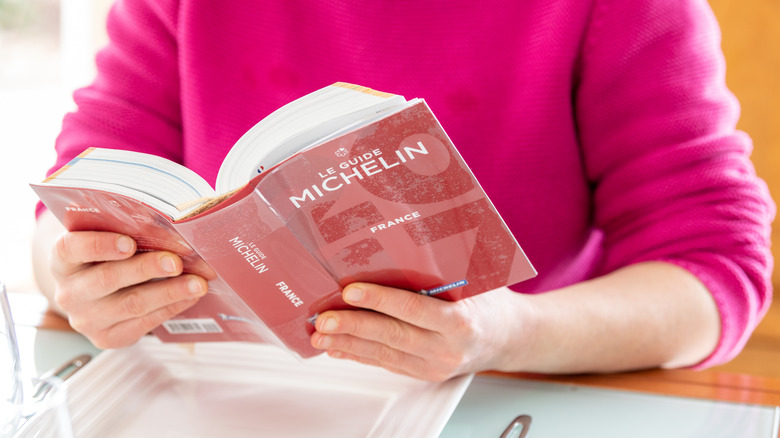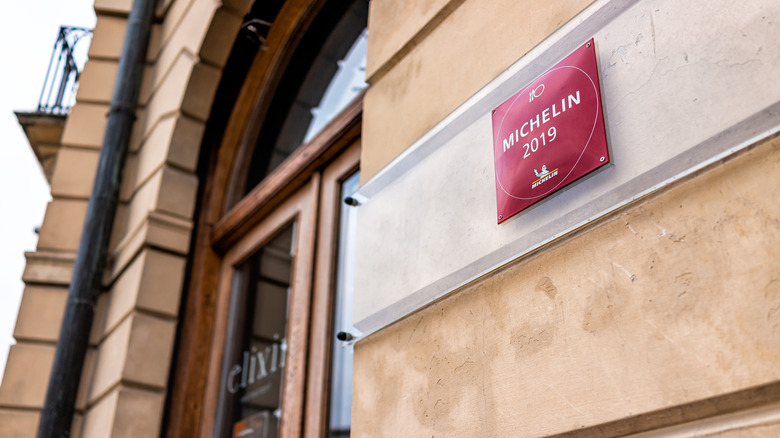What Does A Michelin Star Actually Mean?
The annual Michelin Guide is the ultimate handbook for where to get a really good meal. Just one Michelin star is enough to send people clamoring for a reservation or willing to stand in line to eat at one of these establishments. The stars are handed out annually and worldwide, with France currently boasting 625 stars, and Japan a distant second with 414. A Michelin star represents an endorsement from the Michelin guide inspectors (who remain anonymous), and it's an acknowledgment of peak achievement in gastronomy.
Contrary to popular belief, Michelin stars are awarded to the restaurant, not the chef. Even if a head chef leaves the establishment, the star stays. These stars are awarded to the restaurants that offer amazing food at the highest standards, but the process is not restricted to fine dining; a deserving restaurant doesn't need to have white linen tablecloths, waiters in tailcoats, and a 200-page wine list. In fact, one of the oldest pizzerias in Naples, Italy has one Michelin star and the place is cramped and noisy, with waiters and busboys buzzing around, yet there's always a line of diners around the block waiting to get in because the pizza is so good. According to Michelin, that's what it's all about — the food and the customer.
Consistency is one of the most important factors in judging a restaurant
Earning a Michelin star isn't as easy as cooking one single amazing dish only one time. It's cooking that one amazing dish — and all the others on the menu — to the same high standards every single time. Restaurant owners and head chefs don't know when, or how many times, a Michelin inspector will come to the restaurant, so consistency is key. It's one of the main reasons restaurants lose their Michelin stars; one bad day is all it can take.
Besides consistency, inspectors also look at other factors like ingredients, which play a major part in every aspect of creating a dish worthy of a Michelin star. Whether they're locally sourced or flown in from far-flung regions of the world, the quality of each ingredient is paramount. Chefs will go to great lengths to procure only the best, from forming personal relationships with cheesemongers and artisan bakers, to personally sourcing seafood and produce.
What a chef does with those ingredients to achieve a mastery of flavor and put their creativity and technique on display is also noted. They need to take into consideration flavor profiles and how texture will come into play, which often means using ingredients in novel and interesting ways. On top of all this, chefs must consider the experience of eating the dishes they create.
Earning one star is considered a great achievement
The Michelin Guide started as a travel guide sponsored by the tire brand for road trips; it included restaurant reviews that highlighted many of the characteristics Michelin inspectors look for today — quality, flavor, technique, and personality. Restaurants are awarded between one and three stars, or a Bib Gourmand award, for those restaurants with affordable, delicious, deceptively simple cooking.
Because the guide initially served as a way for drivers to find places to eat on the road, stars are an indication of how far off-route they'd need to go to get to that restaurant. A restaurant that's awarded one star by the organization is considered to be very good in its category. They use the best ingredients and are consistent with their dishes. If the restaurant is on your route, it's worth a stop. Two-star restaurants are worth a detour, with the chef putting out creative dishes made with expertise and the highest quality ingredients. The chef's talents and technique are on display; overall excellent.
Three Michelin stars is the highest distinction awarded by the guide, and it's reserved for the kind of cooking that's worth a special trip; there are only 144 restaurants with this designation in the world. The chefs at these restaurants are at the top of their game and offer first-rate dishes that could be considered art.


